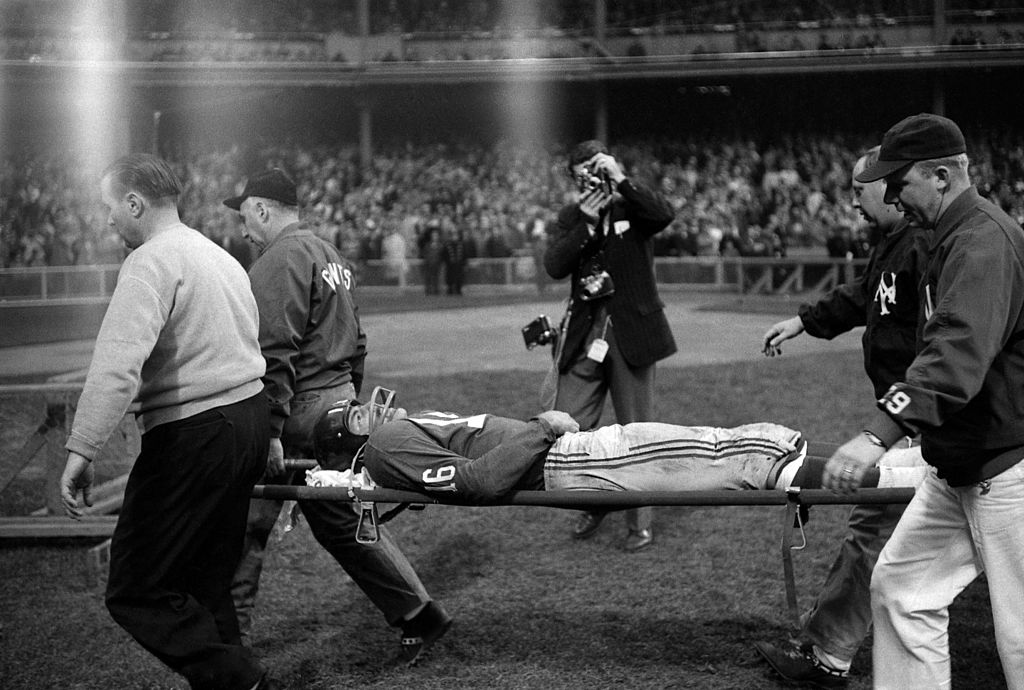NFL
The Facts and Fiction Behind Chuck Bednarik’s Hit on Wide Receiver Frank Gifford

Big hits aren’t celebrated like they used to be, but Chuck Bednarik’s takedown on Frank Gifford remains a part of the NFL folklore. It became known as “The Hit,” and the impact was so severe that some onlookers feared for Gifford’s life. What really happened on that day in 1960? And how did the play affect both the players and the game afterward?
Why is ‘The Hit’ such an iconic play?

RELATED: 49ers Safety Ronnie Lott Sacrificed a Finger to Keep Playing: ‘I Felt Sick’
Up until a few years ago, the NFL’s inescapable violence was a big selling point. Seeing a player laid out on his back during a game or ESPN’s “Jacked Up” segments filled fans with glee.
These days, we’re more aware of the effect of concussions and the general wear and tear that comes with playing football. Regardless, the power of an on-field collision can still shock people. In fact, this play was so jarring to witness that some fans thought Gifford, the player lying on the field, was dead.
The play is now known simply as “The Hit”. On November 20, 1960, the Philadelphia Eagles and New York Giants faced off in Yankee Stadium; first place in the Eastern Division was on the line. As Gifford ran across the field, Bednarik, also known as “Concrete Charlie,” literally upended his life.
The aftermath of ‘The Hit’
RELATED: Are Concussions Really Decreasing in the NFL?
To the surprise of no one, Gifford fumbled the ball. And the Eagles went on to secure a 17-10 victory. Gifford blacked out as soon as he hit the ground. After the game, Giants players returned to the locker room and saw paramedics with a body bag. They feared the worse for Gifford but soon found out the bag was for a fan in the stands who died during the game.
The concussion he suffered as a result sidelined him not just for the rest of that season, but for the entire 1961 season as well. Meanwhile, the Eagles won the NFL title, with Bednarik. He served as one of the last NFL players to star on both sides of the ball. He made another big tackle to seal the deal in the Super Bowl.
But that play didn’t create the mythos of “The Hit.” Bednarik and Gifford’s lives were affected by the incident, and what people thought happened during the incident, for the rest of their lives.
The play became mythologized in the aftermath
The hit that knocked Frank Gifford out of football for over 18 months. RIP Chuck Bednarik. #Eagles pic.twitter.com/0ImR4Nk61h
— Rob Tornoe (@RobTornoe) March 21, 2015
“The Hit” became memorable, not just for its impact in the moment, but also because of how it mythologized afterward. The play was immortalized in this picture from Sports Illustrated staff photographer John G. Zimmerman:
The image captures Bednarik pumping his fist while yelling “This [expletive] game is over.” The reason he’s celebrating so vigorously changes depending on who you ask. The version of events Bednarik told was that he was simply excited; he knew the play put Philadelphia in a great position to win.
This narrative may be true, but it’s also the narrative that maintains Bednarik’s image as a legendary player who always treated his opponent with honor. But it’s hard to look at the picture of Bednarik celebrating while Gifford lies unconscious. He wasn’t the only player who felt a twinge of pride knowing he stopped Gifford in his tracks. But he hid the emotion once he discovered the severity of the injuries in order to maintain his image.
It’s an example of the mentality football players need to survive on the field, but most people don’t want to think about that while they’re watching the game. And most stars like Bednarik are happy if their fans never consider the morality of the product they enjoy so much. It’s easier to sound like a hero that way.
What were Bednarik and Gifford’s careers like after “The Hit”?
In honor of what would have been Chuck Bednarik’s 95th birthday, we’re celebrating the legacy of our 1960 NFL Championship Team.#FlyEaglesFly
— Philadelphia Eagles (@Eagles) May 1, 2020
Gifford eventually recovered and returned to football to play three more seasons. He never criticized Bednarik for “The Hit.” He told The New York Times in 2010, “Chuck hit me exactly the way I would have hit him. With his shoulder, a clean shot. That’s football.” His response was in line with his character.
Gifford’s charismatic personality made him one of the NFL’s first big stars. Men wanted to be him; women wanted to be with him, and he had the talent to justify it. The 1956 NFL MVP was an eight-time Pro Bowler — he was selected to the team while playing in three different positions — and entered the Hall of Fame in 1977. After retiring, Gifford worked as a broadcaster, most notably for ABC’s Monday Night Football telecasts.
Bednarik played in the NFL until 1962, only missing three games in a 14-year career. He was named to the league’s 100th Anniversary All-Time Team, had the college award for the best defensive player named after him, and has his number (60) retired in Philadelphia. Both men accomplished great things on their own, but their legacies will always be connected by “The Hit”.
Content You May Also Like:











